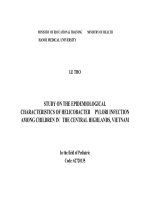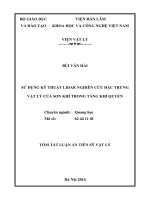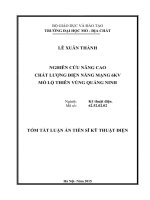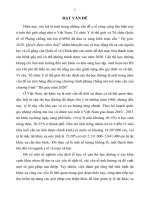tóm tắt luận án ts y khoa tiếng anh nghiên cứu đặc điểm dịch tễ học nhiễm helicobacter pylori ở trẻ em vùng tây nguyên, việt nam
Bạn đang xem bản rút gọn của tài liệu. Xem và tải ngay bản đầy đủ của tài liệu tại đây (386.6 KB, 38 trang )
MINISTRY OF EDUCATION & TRAINING MINISTRY OF HEALTH
HANOI MEDICAL UNIVERSITY
LE THO
STUDY ON THE EPIDEMIOLOGICAL
CHARACTERISTICS OF HELICOBACTER PYLORI INFECTION
AMONG CHILDREN IN THE CENTRAL HIGHLANDS, VIETNAM
In the field of Pediatric
Code: 62720135
SUMMARY OF PH.D THESIS
HANOI - 2014
The Thesis was finalized at:
Pediatric Department – Hanoi Medical University.
Scientific Instructors:
1. Nguyen Van Bang, MD, Ph.D Associate Professor
2. Hoang Thi Thu Ha, Ph.D
Reviewer 1: Pro. PhD. NGUYEN GIA KHANH
Reviewer 2: Pro. PhD. PHAM NGOC DINH
Reviewer 3: Assoc. Prof. PhD. NGUYEN VU TRUNG
The Thesis is defending before at board of Examiners of Hanoi Medical University.
Date and Time: ……/……/2014 … h… ,
The thesis can be found in:
- National Library
- The Library of Hanoi Medical University
- Central Health Information Library
INTRODUCTION
Peptic ulcer is a common infection in the world as well as in Vietnam. The etiology of this disease has been
recognized for a long time. Only until 1983, however, B. Marshall and R. Warren have successfully isolated and
cultured Helicobacter pylori (H. pylori) bacteria. The results from this research have demonstrated the essential
role of H. pylori in the development of the gastroduodenal diseases.
In industrialized countries, the rate of H. pylori colonization ranged from 20-30% and has rapidly
increased to above 50% in people aged 60. Approximately 80% of the children under 15 in 14 developing
countries harbor these bacterial species. In Northern Vietnam, Bang NV et al have estimated an overall H.
pylori infection rate of 34% among 842 children.
The abundant literature has showed that ethnic differences were one of the major influencing factors of
H. pylori infection.
In a study in Asia, Goh et al reported the existence of differences between Malay, Chinese and Indian
children (a low rate amongst Malays and a significantly higher rates in Chinese and Indians). In a study of H.
pylori by Long T.X., Minh L.T and Bang N.V (2007) at Bat Xat district (Lao Cai province) Vietnam, an
overall rate of H. pylori infection in children aged under 18 of 29% was reported. The study also reflected
on a wide variability among different ethnic groups: H’mong 16.1%, Tay 26.7%, Dao 20.3%, Day 38.5%
and Kinh 41.1% .
1
Although several researches on different factors that directly or indirectly affect the H. pylori infection
process have been carried out, a large number of issues related to H. pylori infection still lack of concrete
answers, especially in the areas of routes and time of transmission, pathogenic mechanism, favourable
factors for transmission and prevention methods.
Vietnam is one of developing countries with 54 ethnic groups which have been known collectively
across country. The most recent studies described the rates of H.pylori infection in patients with the disease
occuring on the basis of symptoms or clinical findings. These studies also evaluated the effects of treatment
regimes with drugs that kill the bacteria in aldults and children.
In Northern and some Southern provinces in Vietnam, several studies on H. pylori infection in
children have initially assessed the H. pylori infection rates. However, there remains a paucity of information
on the H.pylori infection rates by ethnic groups, habits and customs; especially by the local ethnic groups are
known collectively in the Central Higlands. As the result, we conducted the study on the epidemiology
characteristics of Helicobacter pylori infection in Vietnames children of the central Highlands ethnic
groups to determine:
1. The rate of H. pylori infection in children of different ethnic groups living in the Central Highlands, Vietnam
from 2010 to 2011.
2. Relative factors for H. pylori infection in children of different ethnic groups, living in the Central
Highlands, Vietnam.
2
SUMMARY OF NEW CONTRIBUTIONS
1/ This is the first thesis to be conducted in Central Highland for identifying the H. pylori infection
rate in children of major ethnic groups in Tay Nguyen, Vietnam.
2/ The thesis had identified several factors relating to the H. pylori infection in the study population.
THESIS STRUCTURE
The thesis consists of 118 pages (not including references and appendices) with 6 parts: Background
(3 pages), Overview (39 pages), Study population and methods (16 pages), Results (28 pages), Discussion
(30 pages), Conclusions and Recommendations (2 pages). The thesis also comprises 5 appendices, 36 tables,
3 figures and 6 illustrations, 171 references including 12 Vietnamese and 159 English.
THESIS CONTENT
Chapter 1 - LITERATURE REVIEW
1. History of Helicobacter pylori research
In 1940, Freedberg discorvered a type of spirochetes in a mucosal resection of resected gastric tissue.
In 1983, B. MarshalL and R. Warren isolated H. pylori bacteria. It was initially called "Campylobacter
like organism", which was, latter, changed to Helicobacter pylori.
From then, there has been being several clinical researches that contributes to the clarification of the
roles of H. pylori in gastroduodenal diseases.
2. Epidemiology
3
1.1 The prevalence of H. pylori in developed countries
The prevalence of H. pylori infection in children is significantly small. Serological-based evidences of
H. pylori infection are rarely found in children who are less than 10 years of age (only around 3 – 5%). In
comparison, the figure increases to 10% for the 18 - 30 age group and 50% for people over 60. The
prevalence of H. pylori tends to be higher for Spanish and Black than White people. This disparity is perhaps
due to the differences in the socio-economic conditions.
2.2 The prevalence of H. pylori in developing countries
In developing countries, the H. pylori infection cases are commonly found in children less than 3
months old. The prevalence reaches 20-40% for children at 2 years old. The highest rate for 2-4 year and 4-6
year groups can be around 40-80% depending on geographic areas. Meanwhile, the prevalence of H. pylori is
significantly high in teenager (15-18 years old) and adult (60-85% and 80-95%, respectively).
2.3 Incidence rate
Overall, the incidence rate in developing countries is between 1 – 5%/person/year. On the other hand,
the rate among children in developed countries is approximately 1%/person/year (0.33 to 2.1 in White
children, 3% in Black children). The new incidence rate remains at 1% in adult.
2.4 Reinfection rate
In developed countries, the reinfection rate is as low as 1%/person/year (0.33-2.1%). The rate in
developing countries, in contrast, is around 13%.
4
2.5 Transmission Mechanism of H. pylori:
Oral-oral pathway - Gastric-oral pathway - Fecal-oral pathway
2.6 Risks factors associating to H.pylori infection in childhood
- Age: H. pylori infection rate is increasing with age - Gender -Income, parents' career and education
background - Socio-Economic conditions - Crowded living conditions - Hygiene condition - Living with
people carrying H. pylori bacteria or having disease due to H. pylori - The role of collective household –
Geography - Race, blood type and ethnicity
2.7. Other factors
Water sources – Animals – Nutrition – Breastfeeding - Antibiotics and proton pump inhibitors (PPI) -
Gastrointestinal disease
3. Diagnosis
3.1.Methods requiring gastrointestinal endoscopy: cytology, detect urease of H. pylori in biospy specimens,
bacterial culture, molecular biology (PCR), antibiogram.
3.2. Methods without gastrointestinal edoscopy : urea breath test using radioactive carbon, antigen in stool
(stool test), salvia and urine test, serological diagnosis
In this research, we have applied ELISA in-house methodology. Serological test, using H. Pylori
strain found in Vietnam and Campylobacter jejuni, by absorbing antibodies, can cause cross-reactivity and
thus, has high sensitivity for Vietnamese children.
5
4. Demographic and geographic characteristics of the Central Highlands population.
- The central Highlands is a plateau region. Ethnic groups living in the area: Bana, Xo- Dang, Gie-
Trieng, Brau, Romam, Mnong, Ma, K Ho, Jrai, Ede, Chu-ru, Raglai, Kinh, Hoa, Tay, Nung, Thai, Dao,
Mong, Bru- Van Kieu etc. Overall, there are nearly 20 ethnic groups.
- In this research, 3 provinces were chosen: Gia Lai, Đak Lak and Lam Dong. 4 ethnic groups were
chosen: Kinh (64.7%), Gia Rai ( 8%), E Đe (6%), K Ho (2.6%).
6
Chapter 2 – STUDY POPULATION AND METHODS
2.1 Study population
2.1.1 Research subject
Children group under 16 year-old with all of their families members living in 7 communes (Nthol Ha, Ninh
Loan, Lien Hiep, Hiep An which belong to Duc Trong district, Lam Đong province. Commune EaTar which
belongs to Cu M Gar district, Dak lak province. Communes (Ia Phi, Ia Khuoi) which belongs to Chu Pah district,
Gia Lai province in The Central Highlands. This sample contains the following ethnic groups: Kinh, K’Ho, Gia
Rai and E Đe.
2.1.2 Research sample
The sample size was calculated using the following formula:
2
1 /2
2
(1 )p p
n Z
d
α
−
−
=
1.96
2
x 0.4 x 0.6
n = = 1.024 children
( 0.03)
2
The number of parrents of 256 households: 512
These created a sample size of 1.536 observations.
7
15% was added for contingency plan, which makes up a sample size of 1.188 children and 712
parents.
2.1.3. Sampling: Selecting samples divided into different levels: from local to commune, consist of: 5 level. Level 5:
select one hamlet of each commune, make a list of households; select the first family, and then " door to door
technique" until the sufficient number of children of each ethnic group is reached.
This was a cross-sectional descriptive research which was conducted, in combination with interviews
with all households and serological tests.
2.1.4. H pylori diagnosis method: Enzyme-linked immunosorbent assay – ELISA
- Carried out serological test for all observations in the sample (including children, parrents,
grandparrents, aunts and uncles living under the same households) using ELISA technique. Serological test
using ELISA technique introduced by Karolinska Institute (Sweden) has been standardized in Vietnam
(sensitivity of 99.6% and specificity of 97.8%). In this research, this test has been carried out at the National
Institute Of Hygiene And Epidemiology with the antibody titer threshold of 0.18 turbidity unit.
2.1.5. Interview Questionaires: all participants were interviewed to investigate different risks factors
associating to H. pylory infection according to a standard questionaire.
RESEARCH ANALYSIS AND PROCESSING
Statistical methods were carried out using SPSS 16.0 software. Results were evaluated using
univariate analysis and multivariate logistic regression analysis.
8
Chapter 3 - RESULTS
3.1. The distribution of research objects by location and H. pylori infection rate of research objects.
Table 3.1 The distribution of research objects by location.
Locality
(province, ethnic
group)
Number of
households
Number
of
Objects
Adult
(%)
Children <
16 years old
(%)
Lam Dong
- Kinh
- K'Ho
- Gia Rai
388
216
171
1
1118
545
567
6
457
230 (29,48)
225 (28,84)
2 (0,25)
661
315 (26,50)
342 (28,80)
4 (0,33)
Đak Lak
- Kinh
- E-De
132
30
102
367
81
286
144
32 (4,10)
112 (14,35)
223
49 (4,20)
174 (14,60)
Gia Lai
- Kinh
- Gia Rai
- E-De
171
18
136
17
483
44
380
59
179
20 (2,56)
138 (17,69)
21 (2,69)
304
24 (2,02)
242 (20,40)
38 (3,30)
Total
691 1.968 780 1.188
9
Table 3.2. The H. pylori infection rate of research objects.
Objects ELISA (+)
Number %
ELISA (-)
Number %
- Father
- Mother
- Grandparent,
grandmarent, aunts, uncles
Children < 16 years old
76
307
30
476
52,02
52,93
55,55
40,07
70
273
24
712
47,98
47,07
45,45
59,93
Total (n= 1968) 889 1079
10
Graph 3.1 The proportion of children under 16 according to age groups
11
45% 55%
38,58%
41,28%
61,42%
58,72%
0,00%
10,00%
Boys
Girls
ELISA (+)
ELISA (-)
30,00%
40,00%
20,00%
70,00%
60,00%
50,00%
Graph 3.2 Distribution of children under 16 according to gender
Comment: Girls was
accounted for 55 %, Boys
was accounted for 45%
Graph 3.3 Prevalence of H.
Pylori infection in children
according to gender
Table 3.3 Prevalence of H.
Pylori infection in
children according to age
group
Age group ELISA (+)
No. %
ELISA (-)
No. %
OR (95% CI)
< 3 year-old (n=243) 68 27,98 175 72.02 1,00
12
P= 0,343
3 – 6 year-old (n=439)
>6 -10 year-old (n=265)
>10 -15 year-old
(n=241)
167
116
125
38,04
43,77
51,87
272
149
116
61.96
56.23
48.13
1.58 (1.13- 2.20)
1.92 (1.33-2.77)
2.67 (1.84- 3.89)
Total (N=1.188) 476 712
As age increases, the Prevalence of H. Pylori infection also tended to increase.
Table 3.4 Prevalence of H. Pylori infection in children according to ethnic group
Ethnic
group
ELISA (+) ELISA (-) OR (95% CI)
No. % No. %
Kinh
K
’
Ho
E Đê
Gia Rai
137
123
101
116
35.30
35.96
47.64
47.15
251
219
111
130
64.70
64.04
52.36
52.85
1,00
1.02 (0.74- 1.42)
1,59 (1.10- 2.29)
1.67 (1.18- 2.37)
There is a significant difference between the prevalence among K Ho group (as well as Kinh) and Gia
Rai (as well as E Đê) group.
Table 3.5. The prevalence of H. Pylori infection according to provinces
13
Province ELISA (+)
No. %
ELISA (-)
No. %
OR(95% CI)
Lam Đong
Đak Lak
Gia Lai
237
96
143
35.69
43.05
47.51
427
127
158
64.31
56.95
52.49
1.00
1.34 (0.96- 1.87)
1.63 (1.21- 2.20)
There is a statistically difference between the prevalence in Gia Lai and in Lam Dong and Dak Lak (OR
(95% CI): 1.63 (1.21- 2.20.
14
3.2. Evaluating the associations between H. pylori infection and other research variables.
Table 3.6 The association between parents’ career and education level with H. pylori infection in children
Parents’ career and
education level
H. pylori infection
condition in children
OR (95% CI)
*
ELISA (+) ELISA (-)
No. % No. %
15
- Father’s career
. Farmer ( n=136)
. Others ( n=10)
- Mother’s career
. Farmer ( n=539)
. Others ( n= 41)
- Father’s education level
Primary school ( n= 88)
Secondary school ( n= 47)
High School ( n= 10)
Undergraduate or above
(n=1)
- Mother’s education level
Primary school ( n= 287)
Secondary school ( n=220)
High School ( n= 70)
Undergraduate or above
(n= 3)
98
7
381
11
41
29
36
10
138
81
139
35
42.24
38.89
39.94
40.74
45.56
38.16
42.35
45.45
41.82
38.21
40.52
35.00
134
11
573
16
49
47
49
12
192
131
204
65
57.76
61.11
60.06
59.26
54.44
61.84
57.65
54.55
58.18
61.79
59.48
65.00
1.00
0.87 (0.30- 2.52)
1.00
1.04 (0.46 -2.37)
1.00
0.78 (0.40–1.53)
0.84 (0.44 -1.62)
1.04 (0.38 -2.90)
1.00
0.89 (0.60- 1.32)
0.96 (0.69-1.34)
0.78 (0.47-1.27)
16
* Adjusted by age and gender
There is no relationship can be found between parents' career, education level and H. pylori infection
conditions in children.
Table 3.7. Association between average income/month/person, number of people in the household and H. pylori
infection in children
Variables
H. pylori infection
condition in children
OR (95% CI)
*
ELISA (+) ELISA (-)
No. % No. %
17
Income/month/person
. <500 thousands/
month/person
. >500 thousands/
month/person
- Number of people in the
household
. ≤ 3 people
. 4- 5 people
. > 5 people
206
270
272
168
36
38.50
41.47
38.10
42.97
43.37
329
381
442
223
47
61.50
58.53
61.90
57.03
56.63
1.00
1.19 (0.92–1.54)
1.00
1.23 (0.93- 1.62)
1.29 (0.69 -2.08)
* Adjusted by age and gender
There is not any association that can be observed between income/month/person, number of people in the household
and H. pylori infection in children.
18
Table 3.8. The association between habits, lifestyle, environmental sanitation and personal hygiene of the study population
and infection condition
Variables
H. pylori infection in children OR (95% CI)
*
ELISA (+) ELISA (-)
No % No. %
- Washing hands before the meal
. No
. Sometimes
. Always
- Washing hands after using the
toilet
. No
. Sometimes
. Always
- Cleaning methods after
defecation
. Only wash
. Mainly wash
. Only wipe
- Eating with bare hand
. Never
39
239
147
40
249
187
68
362
46
285
191
43.82
38.93
33.87
41.24
38.54
42.02
36.17
42.34
31.72
39.09
41.61
50
375
287
57
397
258
120
493
99
444
268
56.1
8
61.0
7
66.1
3
58.7
6
61.4
6
57.9
8
1.00
0.81 (0.51 – 1.30)
0.82 (0.50– 1.32)
1.00
0.87 (0.55 – 1.37)
0.94 (0.59– 1.52)
1.00
1.02 (0.72 – 1.45)
0.89 (0.56– 1.43)
1.00
1.12 (0.87 – 1.44)
19
. Sometimes or always
- Eating together
. Never
. Sometimes or always
- Pre-chew baby’s food
. No
. Yes
- Water sources
. Tap water
. wells
- Raising animals in the house
. No
. Yes (dog, cat, pig, buffalo, cow,
goat)
371
105
324
152
9
467
78
398
39.05
44.12
39.85
40.53
42.86
40.02
38.81
40.32
579
133
489
223
12
700
123
589
63.8
3
57.6
6
68.2
8
60.9
1
58.3
9
60.9
5
55.8
8
60.1
5
59.4
7
1.00
1.28 (0.94 – 1.75)
1.00
1.13 (0.86 – 1.47)
1.00
0.93 (0.36 – 2.41)
1.00
1.03 (0.73 – 1.44)
20
57.1
4
59.9
8
61.1
9
59.6
8
* Adjusted by age and gender
There is not any association that can be found between habits, lifestyle, environmental sanitation and personal hygiene
characteristics and infection condition in children
Table 3.9. The association between toilet system used in the household and H. pylori infection condition
in children
Toilet
H. pylori infection in children OR (95% CI)
*
ELISA (+) ELISA (-)
No. % No. %
. Not available
. septic and
semi-septic
212
264
46.70
35.97
242
470
53.30
64.03
1,00
0.66 (0.51 – 0.85)
21
* Adjusted by age and gender
Children living in household with septic and half septic toilet have 0,34 times lower H. pylori incident (OR
(95% CI): 0.66 (0.51- 0.85)) than children living in household without toilet.
Table 3.10. The association between using fresh stool to fertilize farms/gardens and H. pylori infection in
children
Using
fresh stool
H. pylori infection in children
OR (95% CI)
*
ELISA (+) ELISA (-)
No. % No. %
. No
. Yes
417
59
39,04
49,17
651
61
60,96
50,83
1,00
1,59 (1,05– 2,41)
* Adjusted by age and gender
Children living in households that use fresh stool to feed farms/gardens have 1,59 times higher chance
of getting H. pylori infection comparing to those whose households do not use fresh stool (OR (95% CI) :
1.59 (1.05- 2.41)) .
Table 3.11. The association between a number of children's health characteristics and H. pylori infection
condition in children
22









